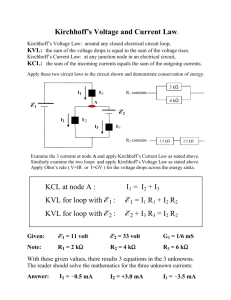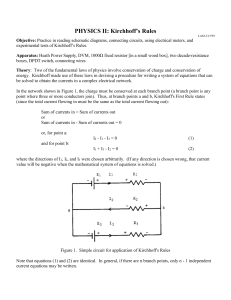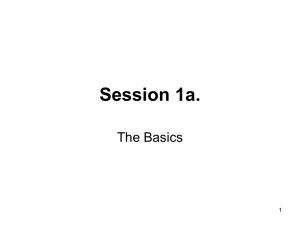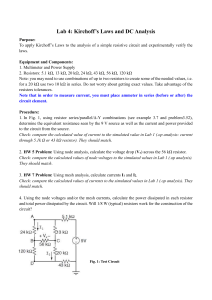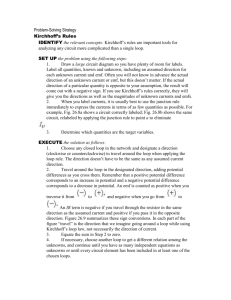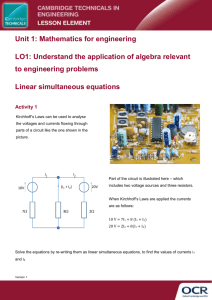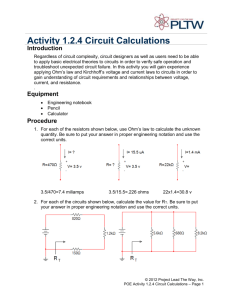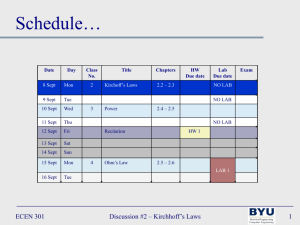Kirchhoff's Laws
advertisement
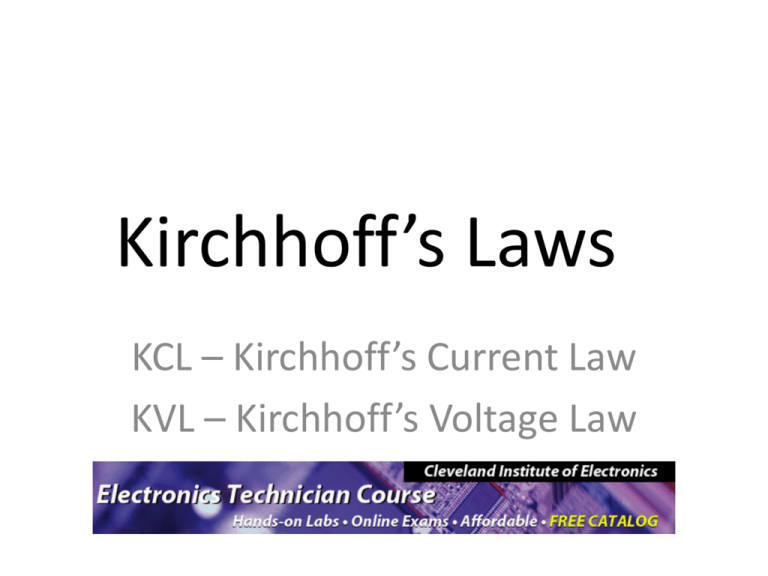
Kirchhoff’s Laws KCL – Kirchhoff’s Current Law KVL – Kirchhoff’s Voltage Law Kirchhoff’s Laws There are a couple of Laws you will need to know well in electronics. They are: – Ohm’s Law – Kirchhoff’s Current Law (KCL) – Kirchhoff’s Voltage Law (KVL) We will discuss Kirchhoff’s Laws in this presentation but Ohm’s Law will be used as well. Kirchhoff’s Laws • The first law, also called Kirchhoff’s current law, states that the algebraic sum of currents entering and leaving any point in a circuit is equal to zero. There was an old saying that went something like, “All roads go to Grandma’s House” Well, if all currents entered a single point in a circuit then we would have an equation like Ia + Ib = 0 Kirchhoff’s Laws • Here are some examples of currents entering and exiting a point in a circuit. • Current Ia enters while Ib exits. Ia - I b = 0 • Currents Ia, Ib and Ic enter while Id exits. Ia + Ib + Ic – Id = 0 Point Z or NODE Z has currents Ia + Ib – Ic – Id = 0 Kirchhoff’s Laws Let us work a circuit problem. We have a Series-Parallel circuit with a current passing through R1 and then about to enter Node A. A current arrow indicates current will flow into resistor R2. Without the arrow, we know current will also flow through resistor R3 and then come together at Node B and return to our source E. The current at Node A is also the current at Node B because what enters a node will exit a node. Kirchhoff’s Laws The circuit shows 10A enters node A and 4A is flowing toward R2. What flows toward R3? KCL states: 10A enters and 4A exits Node A. 10A – 4A = 6A. 6A flows through R3. 4A and 6A are moving toward Node B and they will both enter Node B. 4A + 6A = 10A Kirchhoff’s Laws • A very complex but workable circuit is: Kirchhoff’s Laws Let us determine the currents at P1. Looking back at the circuit we have: I1 = 15A and it enters P1, (enters is positive) I2 = 5A and it exits P1, (exits is negative) I4 = 7A and it exits P1, (exits is negative) I16 = 3A and we don’t know if it enters or exits P1. 15A – 5A – 7A +/- 3A = 0 so we have 3A +/3A = 0 therefore, I16 must be exiting to equal 0. Kirchhoff’s Laws • The second law is Kirchhoff’s Voltage Law that states, the algebraic sum of all voltages around a closed loop equals zero. • A loop is a path so a closed loop is a closed path or complete electronic circuit. • As current passes through a resistor then a voltage is produced. • Current enters the negative side of a component and exits the positive side for Electron Current Flow. Except the source and its polarity is marked. Kirchhoff’s Laws • An example of a circuit with Electron Current Flow is shown: ↘ • E is the source • Current exits the Negative terminal and flows toward A Through R1 out B and around to C through R2 and out D and then back to the positive terminal. Kirchhoff’s Laws The arrow indicates the current flow in the circuit. It is said that the voltage is dropped across the resistor as current passes through the resistor. A “drop” is loss of voltage. A voltage “rise” occurs as current passes from + to – through a component or a source. Kirchhoff’s Laws • Let us look at two examples: • To find E = ? we “walk” around the close loop starting out like current. Leaving the negative terminal I encounter a -25V drop across R1, then a -50V drop across R2 and then a -125V drop across R3. The power supply is from + to – so E is a rise or positive value. My KVL equation is: E – 25V – 50V – 125V = 0. E – 200V = 0. E = 200V. Kirchhoff’s Laws • The second example is: • Pick a point in the circuit and “walk” around the closed loop. Our equation will be: +250V – 30V – 60V – E = 0 Add the values, we get: +250V – 90V = E. Thus, E = +160V. Kirchhoff’s Laws A Ladder Network is complex but it is solved with determination. Yes, the sum of All voltages must add up to 100V. We need to determine V5. Each window pane is a closed loop! Take the path from Nodes f to e to b to a and back to f. No voltage from f to e. From e to b is a rise because current enters at the top of R5. From b to a we also have a voltage rise. From a to f we drop voltage since we are going from – to +. So, V5 + 30V – 60V = 0 V5 – 30V = 0 V5 = 30V Kirchhoff’s Laws The End
